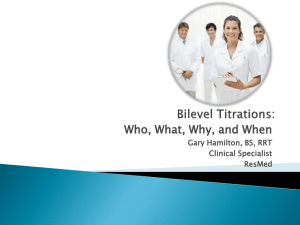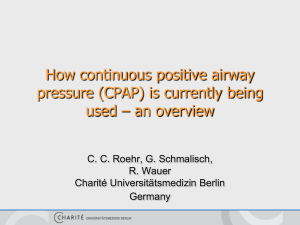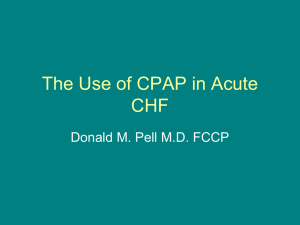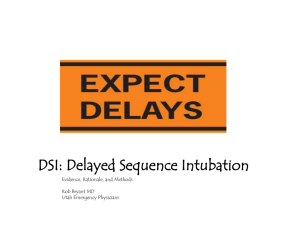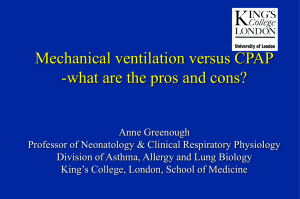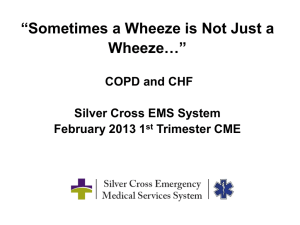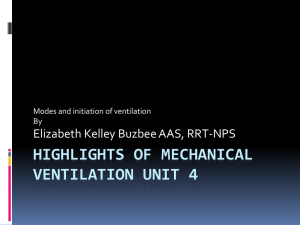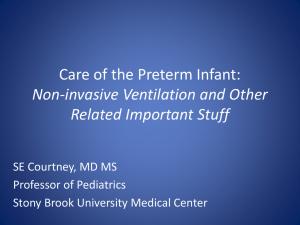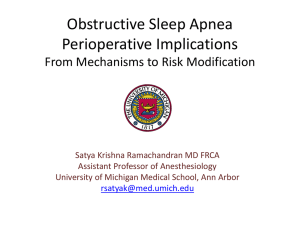A History of CPAP for Infants
advertisement
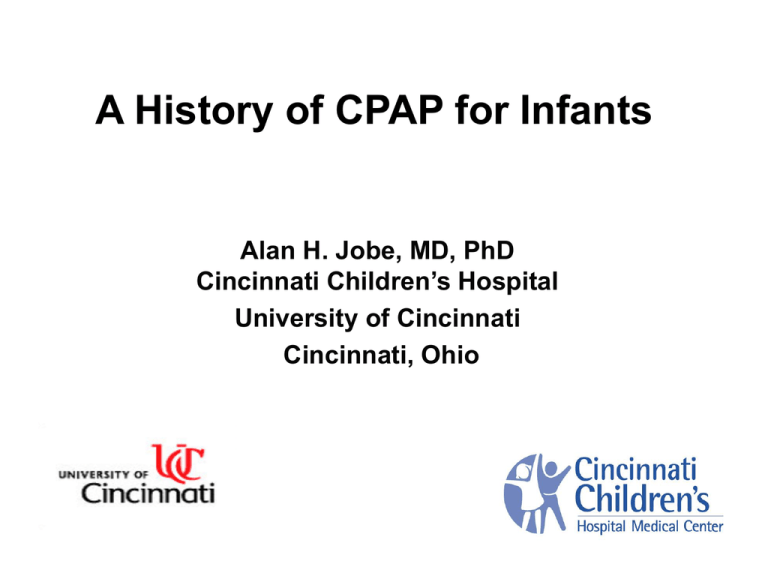
A History of CPAP for Infants Alan H. Jobe, MD, PhD Cincinnati Children’s Hospital University of Cincinnati Cincinnati, Ohio Neonatal Bioethics: The Moral Challenges of medical Intervention • The era of innovation and individualism 1965-1982 – – – – Mechanical Ventilation CPAP Total Parental Nutrition Regionalization • Era of exposed ignorance – 1982-1992 • The End of Medical Progress – after 1992 Lantos and Meadow, Neonatal Bioethics, 2006 First Reference to CPAP in Pub Med: Revival of an Old Battle: Intermittent vs. Continuous Positive-Pressure Breathing • Continuous Pressure Breathing – effective in WWII for high altitude pilots, but increases work of breathing and decreases cardiac output. • Advantages of CPB over IPB – Improved oxygenation at lower FiO2 • Disadvantages of CPP over IPB – Need to measure CO – “Indicated only in cases where alveolar pressure is not transmitted to the intra plural spaces” – Alveolar rupture and Pneumothorax VIENNA-09 Editorial in NEJM – December, 1970, Claude Lenfant 8 Patients with “Severe Acute Respiratory Failure” Ventilated using a PEEP of 13 cmH2O Kunar, et al., NEJM, 1970 VIENNA-09 Responses of Switching 8 Patients from PEEP=13 cmH2O to No PEEP Kunar, et al., NEJM, 1970 VIENNA-09 Status of Hyaline Membrane Disease – Late 1960’s • HMD was leading cause of death for preterms (27%-43% survival with assisted ventilation worldwide) 1968-1971 • Ventilation resulted in Bronchopulmonary Dysplasia (oxygen toxicity) – Northway (1967) * No antenatal testing for lung maturation – (Gluck, 1971) * No antenatal corticosteroids (Liggins – 1972) * No surfactant treatments (Fujuwara – 1980) * No effective therapy other than supplemental oxygen VIENNA-09 Information about HMD in Late 1960’s • Atelectasis in HMD interfered with oxygenation • Normal lungs contained surfactant (Clements – 1957) • HMD lungs were surfactant deficient (Avery and Mead – 1959) • Intubation of HMD infants abolished grunting and decreased oxygenation (Harrison, et al., 1968) • Ventilation with a long Ti increased oxygenation (Smith, et al., 1969) VIENNA-09 Pediatr, 1968 VIENNA-09 5 Infants tested for change in Oxygenation with Intubation - on 90-95% Oxygen PaO2 Values Before Intubated 91 ± 91 Intubated 61 ± 58* Extubated 93 ± 92 *1.8±0.4 kg; Pco2=51±7 p<0.001 Harrison, et al., Pediatr, 1968 Nasal Piece and Fleish Tube used for PFT Measurements Fig. 1. Fleisch 00 Pnumotachograph, T-junction, and nasal piece. Harrison, et al., Pediatr, 1968 Abstract for SPR/APS Meeting 1970 VIENNA-09 VIENNA-09 20 Infants Treated with CPAP over 16 Months 51 Infants with IRDS UA lines, O2 for Pao2 of 50-70 mmHg 25 - Increased O2 Only All Survived 20 - Required 100% or had Apnea 5 - Apnic at Birth 1 - Ventilated from Birth Bag & Mask Ventilation Ventilated 1 Survived CPAP All Died 16 Survived VIENNA-09 Data from Gregory NEJM, 1971 CPAP Device for use with Endotracheal Tube Gregory, et al., NEJM, 1971 VIENNA-09 CPAP Device for use with Endotracheal Tube Gregory, et al., NEJM, 1971 VIENNA-09 Head Box for CPAP without Endotracheal Tube VIENNA-09 Gregory, et al., NEJM, 1971 Provided by G. Gregory Results: Provided by A. Wilkinson • CPAP 0 (mmHg) 6 FRC (ml) Provided by A. Wilkinson CPAP (mmHg) From Gregory, et al., NEJM - 1971 • “We did not consider an elevation in Paco2 to be an indicator for mechanical ventilation as long as pH was greater than 7.20.” • Footnote for physiologic data – – Order NAPS document 01448 from National Auxiliary Publications Service – (the physiologic data has been lost) VIENNA-09 CPAP Worked – and Rapid Innovation Occurred • Continuous negative Pressure (Chernick and Vidyasargar – 1972) – Fanaroff, et al. (1973) • Pressurized bag over head (Barrie, 1973) • Mask that covers the mouth and nose (Harris, 1972) • Nasal CPAP (Kattwinkel, et al., 1973) • Ventilation + CPAP = PEEP (Cumarassamy, et al., 1973) VIENNA-09 A Bag and Y-Connector for CPAP VIENNA-09 Barrie, The Lancet, 1973 Caliumi-Pellegrini, et al., Arch Dis Child, 1974 VIENNA-09 Schematic representation of the system used for applying continuous positive airway pressure (adapted from Gregory, et al.) VIENNA-09 Cumarasamy, et al., Pediatrics, 1973 Artificial Ventilation in HMD: the use of PEEP and CPAP Treatment Outcomes with PEEP + CPAP by Year Years Number of Patients % Ventilated % Survival Overall Ventilated 1969 1970 1971 36 36% 38 58% 46 78% 53% 44% 74% 23% 23% 70% Cumarasamy, Nussli, Vischer, Dangel & Duc, Pediatrics, 1973 VIENNA-09 Effect of CPAP (PEEP) on Intubated and Ventilated Infants with RDS VIENNA-09 deLemos, McLaughlin, Robison, Schulz, Kirby, Anesthesia & Analgesia, 1973 Nasal Prongs for CPAP Kattwinkel, Fleming, Cha, and Fanaroff, Pediatrics, 1973 Nasal CPAP (2-5 cmH2O) for Infants with Apnea. BW average = 1kg, age of study – 14 days Kattwinkel, et al., J. Pediatr, 1975 Follow-up Measurements to Evaluate Mechanical Ventilation, Oxygen, and CPAP for Lung Damage Ventilated CPAP Number 11 8 Birth Weight (kg) 1.6±0.2 2.2±0.2 Gestational Age (weeks) 31.7±0.6 34.1±1.1 Duration of Supplemental O2 > 60% (hr) 38±10 11±3 Duration of IPPV (hr) 56±10 Duration of CPAP (hr) 48±9 Stocks and Godfrey, Pediatrics, 1976 Airway Conductance Measured at Term and at 411 Months Post-Delivery CPAP Stocks & Godfrey, Pediatrics, 1976 Meta-Analysis of CPAP vs. No CPAP for Infants with RDS Outcome Require Mech Vent Air Leaks BPD Death NNRisk Studies Patients Ratio 4 145 0.66 4 165 2.62 2 100 0.87 4 165 0.66 95% CI 0.50-0.86 1.28-5.36 0.33-2.31 0.45-0.97 Bancalari & Sinclair, in Effective Care of the Newborn Infant: Sinclair and Bracken, 1992 1980’s through early 2000 • Ventilation replaced CPAP as primary therapy for RDS • Antenatal steroids and surfactant decreased severity of RDS • BPD was frequent in VLBW infants CPAP was used frequently for • Apnea of prematurity • Post extubation after mechanical ventilation • RDS in some locations (Columbia, Univ. Scandinavia) CPAP-VENT Effect of a change in delivery room management for infants <1000g - allowing spontaneous breathing with FRC recruitment and CPAP (N) Intubation & Vent in DR Never intubated Pco2 on NICU admit BPD IVH G III & IV Death 1994 (56) 84% 7% 3811 mmHg 32% 24% 27% 1996 (67) 40%* 25%* 5415 mmHg* 12%* 12% 22% Lindner et al., Pediatr. 103:961, 1999 IMHR PI CPAP-VENT The Danish Approach to the Initiation of Ventilation and Surfactant Description of Population of Infants <30 Weeks GA Number GA BW Antenatal Steroids Initially given CPAP No or Mild RDS Given Surfactant Ventilated by 7d Ve rd e r, et al Nu tr i CPAP-VENT 397 27.2±1.6 1033±274 80% 94% 54% 30% 42% . , P e d i a tr . 103: e 24 , 1999 The Coin Trial Ventilation CPAP P N 303 307 BW 952 964 % Intubated by 5d 100% 46% * % Surfactant by 5d 77% 38% * Morley, et al., NEJM, 2008 Ventilation CPAP Pneumothorax Median Vent days Death BPD - 28d BPD - 36wk O2 Concentration at 36wk >30% P 3% 4 5.9% 63% 31% 9% 3 6.5% 51% 29% <0.01 <0.01 NS 0.01 NS 8.8% 9.4% NS Morley, et al., NEJM, 2008 Neonatal Bioethics: The Moral Challenges of medical Intervention • The era of innovation and individualism 1965-1982 – – – – Mechanical Ventilation CPAP Total Parental Nutrition Regionalization • Era of exposed ignorance – 1982-1992 • The End of Medical Progress Lantos and Meadow, Neonatal Bioethics, 2006 CPAP in 2009 – A New Enthusiasm • Again frequently used as an initial therapy for RDS ± surfactant • Early (delivery room) use popular and under study • New types of CPAP – Nasal CPAP + Ventilatory assist (synchronized, NAVA) – Multiple CPAP devices (NeopuF) – High flow nasal cannula – Variable pressure CPAP My thanks to George Gregory for his help with this brief history of CPAP

